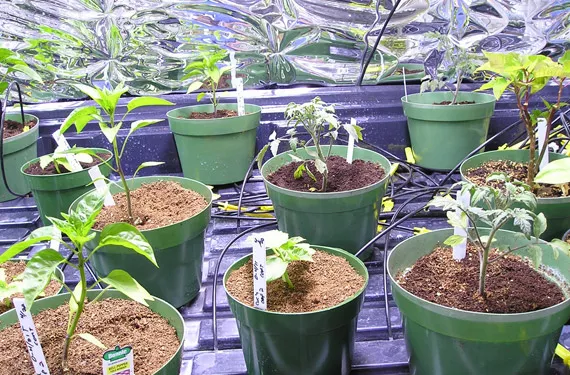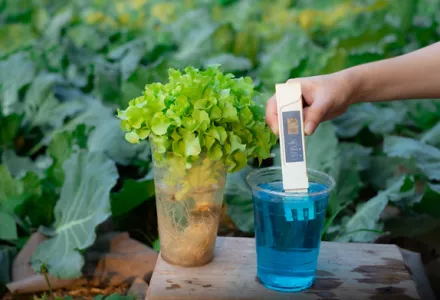In order to choose the fertiliser that best suits our needs, or to be able to compare our choice with similar products, it is important for us as growers to know the full range of nutritional elements in a particular fertiliser. For this we consult the product label, where we find information on the proportions of nitrogen, phosphorus and potassium (the NPK or N-P-K).
However, sometimes we have discovered that while the label on fertiliser X shows NPK ratios ten times greater than those of fertiliser Y, the amount of each to be added per litre of water is exactly the same. This happens because the NPK proportions that we are comparing sometimes use different systems of measurement.
Different ways to express the amount of nutrient
There are many ways of describing the amount of nutrients in liquid fertilisers. The NPK level in a liquid fertiliser can be referred to without taking into account the water in which it is diluted. In other words, the idea is to identify each nutrient proportionally with respect to all the elements in the fertiliser. For example, a fertiliser classified as 26-23-29 has a nitrogen content corresponding to 26% of all the elements in that particular mix. As you can see, this representation of the concentration levels is characterised by very high numbers.

Another option is to express NPK levels in terms of presence per unit of volume. A 3-3-2 liquid fertiliser, for example, is one with 3 grams of nitrogen per 100 ml of fluid. This system is referred to as weight/volume (w/v), a method that calculates only the volume into which the fertiliser substances are dissolved rather than the weight they add to the solution.
A third alternative is based on the amount of NPK present in a liquid fertiliser, a system known as weight/weight (w/w). We know that a litre of water weighs 1 kilogram, and after we mix in the liquid fertilizer components, the resulting weight is that of the water plus the weight of fertilising elements and other products, including humic acid, buffer materials etc. The result: a litre of liquid fertiliser will always weigh more than 1 kilogram.
Density of a solution
The number of grams of dissolved solids per litre of water is what we call density. A density of 1 applies to water in which nothing has been dissolved (distilled water, for example). The more solids we dissolve, the greater the density. For example, a 2-2-1 label on a litre of fluid fertiliser weighing 1.2 kilograms indicates that in every 100 grams of liquid there are 2 grams of nitrogen. Multiplied by the density, the result is the concentration expressed in terms of w/v (as explained in the previous paragraph).
This explains why we cannot jump to conclusions about which fertiliser is more concentrated, even when labels on two products present equal NPK ratios, as concentration is determined by density. The first conclusion we can reach is that the ratio numbers expressed as w/v are larger than those expressed as w/w.
In order to supply sufficient nutrition to plants using two fertilisers marked with w/w NPK ratios (the expression of their concentration), the amount in millilitres to be added from each one can be determined in the following ways:
- If the density of the product is known, all we have to do is multiply this figure by the given w/w proportions and we will have the ratio expressed in w/v. This also
tells us how many grams of nutrients there are per millilitre. - If the density of the liquid fertiliser product is unknown, we have several options. A densimeter can be used to determine density, or we can weigh a litre of the product. If we still cannot determine the density, there is another possibility on the label of the concentrate, where, in general, manufacturers provide indications for the amount of fertiliser concentrate recommended per litre.
As you will have seen by now, these methods merely serve to illustrate, and they lack precision, some more than others. The only way to obtain more accurate and reliable information on the total quantity of nutrients we are adding to the water for our plants is to measure the electrical conductivity, or EC. It is important to point out that organic manure or soil additives contain organic nutrients or trace elements, vital to our calculations, but which escape detection by the EC meter. In general, this means that if you also use soil additives in the care of your plants, the concentrate's EC should be slightly lower than that of mineral soil additives or fertilisers.

Concentration depends on density
With all of the above information in mind, we can draw the following conclusions: the w/w ratio represents lower amounts than those of the w/v ratio. For this reason, if we are going to compare two fertilisers, the first thing we have to do is to take note of the measuring system used for representing the nutrients. But even so, the w/w ratio does not provide exact information on the concentration, as this depends on density. In order to determine which fertiliser is more concentrated, following the manufacturer’s instructions on the required dose helps to give us an idea, if density and w/v are unknown.
The best indication is given by dissolving equal amounts of both concentrates in a litre of water and measuring the mixes to find the highest level of electrical conductivity.









